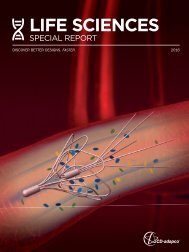Life Science Special Report December 2015
The Life Sciences Sector is experiencing an unprecedented change...
The Life Sciences Sector is experiencing an unprecedented change...
- No tags were found...
You also want an ePaper? Increase the reach of your titles
YUMPU automatically turns print PDFs into web optimized ePapers that Google loves.
BLOOD FLOW SIMULATIONS LIFE SCIENCES<br />
domain with the blood being modeled as<br />
a Newtonian fl uid with constant viscosity.<br />
The infl ow conditions for blood fl ow into the<br />
artery were considered to be non-pulsatile<br />
in the initial stage with further simulations<br />
incorporating transient pulsatile fl ow as the<br />
boundary condition. The walls of the vessel<br />
were considered as rigid, no-slip walls.<br />
EXPECTED VALUE<br />
OF SIMULATION<br />
Figure 4 shows the contours of a passive<br />
scalar advected with the blood flow on<br />
planar sections at constant intervals along<br />
the artery, vein and the AVF connection<br />
for one of the designs. The concentration<br />
of the passive scalar gives a visual<br />
indication of how the blood is mixed in<br />
the AVF. The results from the simulation<br />
enable a qualitative assessment of the<br />
blood flow patterns. The non-physiological<br />
hemodynamics in this region causes WSS to<br />
fluctuate greatly. This behavior could result<br />
in the failure of the AVF due to inflammation.<br />
The passive scalar concentration along a<br />
centerline plane in the AVF is seen in figure<br />
5, showing uneven mixing of the blood at<br />
the junction of the AVF. Figure 6 shows<br />
streamlines of the blood flow through the<br />
connection. Such results from STAR-CCM+<br />
enabled the research team to clearly identify<br />
areas of recirculation, swirl, high vorticity,<br />
high velocity and high/low wall shear stress<br />
in the fistula area. The hemodynamic<br />
parameters can also be studied<br />
individually upstream and downstream<br />
of the fistula to identify problem areas.<br />
CONCLUSION<br />
The team of researchers from Imperial<br />
College London is undertaking numerical<br />
simulations to improve clinical outcomes<br />
for dialysis patients and reduce the<br />
financial burden for healthcare providers,<br />
by developing better designs to decrease<br />
the failure rates of AVF. Reduced rates of<br />
AVF failure will lead to improved patient<br />
experience, survival rate and cost-utility,<br />
making dialysis potentially affordable for<br />
lower-income populations. It is hoped<br />
that results from the study will also help<br />
solve a range of other long-standing<br />
healthcare problems, such as failure of<br />
vascular stents, arterial bypass grafts<br />
and organ transplants, due to IH. The<br />
ultimate objective of the research team<br />
is to provide guidance to the surgeons<br />
on the confi guration of AVF for healthy<br />
fl ow patterns and reduced potential<br />
for failure. This serves as an excellent<br />
example of the far-reaching impact of<br />
numerical simulation into our daily life,<br />
helping save lives with the same ease<br />
as which it helps to build products.<br />
FIGURE 4: Concentration of a passive<br />
scalar, advected with blood fl ow, on<br />
different plane sections along the artery,<br />
vein and AVF<br />
FIGURE 5: Concentration of a passive<br />
scalar, advected with blood fl ow, on a<br />
centerline plane section in the AVF<br />
FIGURE 6: Streamlines showing fl ow<br />
features inside the AVF<br />
THE RESEARCH TEAM<br />
DR. PETER VINCENT<br />
Department of Aeronautics, Imperial<br />
College London - CFD Lead<br />
PROF. COLIN CARO<br />
Department of Bioengineering,<br />
Imperial College London -<br />
Bioengineering Lead<br />
DR. NEILL DUNCAN<br />
Imperial College London, Renal and<br />
Transplant Centre, Hammersmith<br />
Hospital - Clinical Lead<br />
MISS LORENZA GRECHY<br />
Department of Aeronautics, Imperial<br />
College London - CFD<br />
MR FRANCESCO IORI<br />
Department of Bioengineering,<br />
Imperial College London - CFD<br />
DR. RICHARD CORBETT<br />
Imperial College London, Renal and<br />
Transplant Centre, Hammersmith<br />
Hospital - Clinical<br />
PROF. WLADYSLAW GEDROYC<br />
St Mary’s Hospital - Clinical<br />
JEREMY CRANE<br />
Imperial College London, Renal and<br />
Transplant Centre, Hammersmith<br />
Hospital - Surgical Lead<br />
DR. MARC REA<br />
Imperial College NHS Healthcare<br />
Trust - Clinical<br />
THIS ARTICLE IS PART OF A TWO-SERIES<br />
SPOTLIGHT ON THE LIFE SCIENCES RESEARCH<br />
BEING CONDUCTED AT IMPERIAL COLLEGE<br />
LONDON ON DIALYSIS TREATMENT. THE<br />
NEXT EDITION OF DYNAMICS WILL FEATURE<br />
A FOLLOW-UP ARTICLE DELVING INTO THE<br />
DETAILS OF THE RESEARCH FINDINGS.<br />
REFERENCES:<br />
[1] Feldman, H., Kobrin, S., Wasserstein, A. (1996): Hemodialysis vascular<br />
access morbidity, J. Am. Soc. Nephrol., 523–535, 1996.<br />
[2] Loth, F., Fischer, P. F., & Bassiouny, H. S.: Blood Flow in End-to-Side<br />
Anastomoses, Annual Review of Fluid Mechanics, 40(1), 367–393, 2008.<br />
[3] Sivansesan, S., How, T.V., Black, R., Bakran, A.: Flow patterns in the radiocephalic<br />
arteriovenous fi stula: an in vitro study, Journal of Biomechanics, 32(9), 915–925, 1999.<br />
[4] Huijbregts, H. J. T., Bots, M. L., Wittens, C. H. a, Schrama, Y. C., Moll, F. L., Blankestijn, P.<br />
J.: Hemodialysis arteriovenous fi stula patency revisited: results of a prospective, multicenter<br />
initiative, Clinical journal of the American Society of Nephrology: CJASN, 3(3), 714–9, 2008.<br />
[5] Sivansesan S, How T.V., Bakran A.: Sites of stenosis in AV fi stulae for<br />
haemodialysis, Nephrol Dial Transplant 14: 118–120, 1999.<br />
All images courtesy of Imperial College London.<br />
SPECIAL REPORT<br />
21



